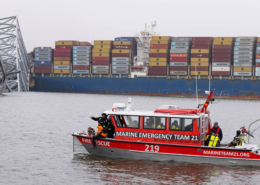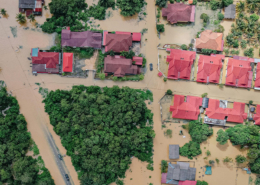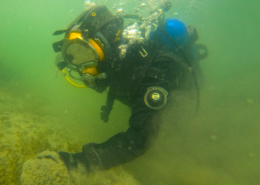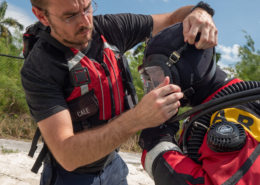You’ll Be Surprised What Firefighters Can Do with the Right Training and Dive Gear
By: Christopher J. Atkins
Often we see in life how some things are perfect pairings, such as peanut butter and jelly, macaroni and cheese, not to mention peas and carrots (thanks Forrest). Another great matchup involves two different genres of public service, each vitally important. Many times, the worlds of the fire service and dive rescue will collaborate.
Why does this seem to be the case?
To understand how this collaboration is successful, you have to look at various internal factors for both firefighters and dive rescue personnel. With each discipline, first, you need members that are willing to do the job. Neither are simplistic, ordinary pursuits as each involves stressful situations with life or death decisions. Therefore, personnel have to be mentally tough to withstand this stress. Members must also be willing to perform difficult tasks, possibly as an individual, but within the construct of a team. Within each area of expertise, you are placed in environmental conditions that are at best just unsafe, but at worse life threatening.
Members must undergo very technical based training to bring them to the level that they can successfully complete required tasks and missions. Neither the fire service or dive rescue allow persons to run off the street and straight into the hazards of the mission. The required training takes months and often years of training just to be a considered competent and knowledgeable within their field of study. This training does not stop; it should continue throughout a member’s career as they seek to improve knowledge, skills, and abilities.
The technical training that individuals will take to become Public Safety Divers can take many different avenues and encompass many different skill sets. Through a proper credentialing and training provider, such as ERDI, the transition from firefighter to Public Safety Diver is a logical process. There are a multitude of training programs available through ERDI, such as Confined Space Operations, Contaminated Water Ops, Small Boat Ops, Night Ops, Swift water Ops, etc. This does not include the initial Open Water Scuba Diver course to get all divers started, along with Full Face Mask and Dry Suit Operations. What the dive team gets credentialing in depends on environments encountered and services that may be required.
Look at the basics of each discipline and associated tasks or missions.
Within the fire service, you are required to enter a structure, house or commercial building, to search for victims trapped by fire and stretch hose lines to extinguish fire. The environment encountered involves high heat, thick smoke, limited visibility, unfamiliar locations with trip hazards, and possibility of being involved in collapse of the building. Comparing this to missions that the dive rescue member may be involved in, it does not change much. The diver is put in murky, contaminated water with limited visibility, entanglement hazards, and entrapment within confined areas. Both environments are not conducive to survival, making the firefighter and diver dependent on their training, equipment, and inner resolve to complete the mission.
When the public safety dive team is called into action, there are various mission types that they will be expected to handle. Again, these missions will mirror what the member may encounter as a firefighter. As a PSD team, members will be requested for victims that are ‘trapped’ in water and unable to self-rescue, a vehicle in water with/without victims, or other special situations. The member will be expected to work in tenuous conditions, often to only find the victim deceased or no victim at all. There are occasions that the PSD team may be requested by law enforcement to assist in evidence recovery for criminal cases. This will require confidentiality on the part of the team members and an understanding of how evidence recovery and custody works.
Although the equipment used by each discipline may vary in design, the purpose is very similar.
The firefighter and diver require an air supply which is carried in by each member and limited in duration. Each need Personal Protective Equipment (PPE) and depend on this for their safety. Communication equipment ensures that members operating in their perspective hazard areas can talk to other members as well as to tender/team leaders and Incident Commanders.
So, we have addressed how the fire service and dive rescue correspond to each other in member skills, equipment, and mission basics. Seeing how these backgrounds line up, wouldn’t it be a natural fit for the fire service to assume dive rescue capabilities? This is dependent on the need for a dive rescue team in the area and the fire service able to absorb the additional responsibilities and financial burden.
By taking firefighters, who by nature have a desire to help others, are Type A, already highly trained and motivated, and familiar with the dark and unknown, it is an easy stretch to develop a dive rescuer. This is not to say everyone will seek out this new assignment, just as some enjoy working with Hazardous Materials and others like to hang off a building with a rope, but it can be a natural extension.
If we have a need to create a new fire service based dive rescue team, we have a base group of individuals to select for membership. The selection of those special individuals who desire and are willing to take on this new assignment ensures that the dive rescue team will be highly trained, motivated, and successful. It should be no surprise that highly trained firefighters/PSDs with proper gear can accomplish a multitude of missions, provide lifesaving service, and protect each other no matter which environment they find themselves.


 Photo By: Defense Visual Information Distribution Service
Photo By: Defense Visual Information Distribution Service


 Y. ZIN
Y. ZIN


Leave a Reply
Want to join the discussion?Feel free to contribute!